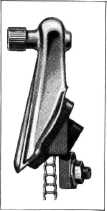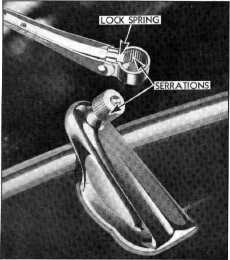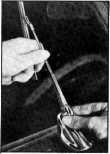1942 - 1947 CHEVROLET SHOP MANUAL
Section 1 Body
|
|
|||||
|
1-34
|
|||||
|
|
|||||
|
of the shaft match the internal serrations in the
hub or cap section of the wiper
arm, Fig. 75.
|
in the chain of one or
both transmission and link assemblies may result in short or uneven
stroking. To correct this condition loosen the hex nut at the bottom
of the transmission and link, Fig. 77, (reached up under
the instrument panel) and
move the bolt and nut downward to take up all slack in the
chain, then retighten the nut.
BODY LUBRICATION
Many of the annoy-
|
 |
|||
 |
|||||
|
ing squeaks and noises
|
Fig. 77-Windshield
Wiper Transmission Link Chain
|
||||
|
that occur in closed bodies are
due to neglecting a very
important maintenance service
which all bodies should receive
regularly.
The body lubrication
chart, Fig. 78, gives the location of all lubrication points.
The movable mechanical
parts of the body are lubricated
at the factory for easy operation and to eliminate squeaks
caused by frictional contact. This lubrication should be maintained
and replenished at periodic intervals.
Most body lubrication
points do not carry heavy loads like the chassis, and for this reason
many of the points do not require as heavy nor as frequent lubrication
as the chassis points.
For body lubrication,
a specific kind of lubricant, the one best suited for individual
points, should be used. Knowing what to use and where to use it,
together with a little care and cleanliness, will bring many returns
in the satisfaction and pleasure of driving a car properly serviced.
For exposed surfaces,
such as door checks, door lock bolts, lock striker plates, dovetail
bumper wedges, etc., a sparingly applied, thin film of clean,
stainless grease or other similar lubricant will be as lasting and
more economical than a large, messy smear of any lubricant carelessly
or thoughtlessly applied.
Where oil holes are
provided in body parts a dripless oil can be safely used, but any
lubricant should be used sparingly, and after application all excess
should be carefully wiped off.
The seat adjusters
and seat track, ordinarily overlooked, should be lubricated with cup
grease, graphite grease, or dripless oil—used sparingly.
There are other points
on bodies which may occasionally require lubrication and which are
|
|||||
|
Fig. 75-Windshield Wiper Shaft and Arm
Cap Serrations
Two different methods
of locking the arm to the serrated shaft are used. To remove the type
using the wire catch in the shaft recess, it is only necessary to
trip the catch to free it from the recess at the back of the serrated
section, then pull outward or the cap section of the arm.
|
|||||
 |
To remove the type
using the flat spring, pull
the blade end of the arm away from the glass while at the same time
pulling outward on the hub section of the arm, Fig. 76. On this type,
pulling the arm away from the glass causes
the flat spring to be
lifted from the recess in
|
||||
|
the shaft, Fig. 76.
|
|||||
|
Fig. 76-Removing
Windshield Wiper Arm and Blade
|
To properly adjust the
|
||||
|
stroke or sweep of the
blades, first wet the windshield, then turn the
wiper on to run at about half
speed and note the sweep or travel. Then remove one or both wiper arms
and change to whatever position may be
necessary on the shaft to provide
the proper stroke or
sweep.
In some cases
excessive play or lost motion
|
|||||
|
|
|||||